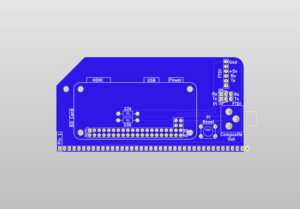The Pi Zero Serial Terminal module allows you to plug the RC2014 in to an HDMI monitor or TV and a USB keyboard, thus use it without the reliance on another computer. [Ok, yes, you are still relying on another computer – the Pi Zero – but it’s small and neat within the RC2014 footprint]
History of this module can be tracked through Hackaday.io
There are two aspects to this module; software and hardware
Software
PiGFX is ANSI serial terminal software developed by Filippo Bergama. It is a bare metal program that runs directly on the Pi Zero from SD card – thus it runs instantly on power-up and doesn’t rely on Linux or other underlying operating system. It is ANSI compatible, so supports escape codes for things like colour and positioning, as well as extended escape codes for primitive graphics. The software has been optimised for RC2014 and needs only 3 files on the SD card to run. See the GitHub repository for further info
Hardware
Fundamentally, this is just a serial terminal, so it only needs to connect to power, tx and rx on the backplane. The Pi Zero is not 5v tolerant though, so the tx pin from the RC2014 goes through a voltage divider made of 2 resistors. The 3v3 tx pin from the Pi Zeor is sufficient to drive the 68B50 on the Serial I/O Module, so there’s no need to do anything there.
The reset pins for the Pi have been bought out to a switch and the composite output has been bought out to a phono socket connector. If no HDMI connector is detected when the Pi powers up, it will default to this composite output.
The tx and rx pins go through a couple of jumpers which allow the signals to be diverted through an FTDI connector. This can be handy, for example, if you wish to use a serial keyboard instead of the USB keyboard connected to the Pi.
Bill of Materials
- RC2014 PI PCB1_1
- 36 pin RA header 1
- 20 pin header 2
- 6 pin RA Header 1
- 2 x 20 pin socket 1 \ 2×5 pin and 2×4 pin socket may be used
- 2 pin socket 2 /
- 2 pin header 2
- 3 pin header 2
- jumper 2
- Micro SD Card 1
- Mini HDMI Adapter 1
- PCB Spacers 11mm 4
- M3 6mm bolts 8
- 22k Resistor 1
- 10k Resistor 1




